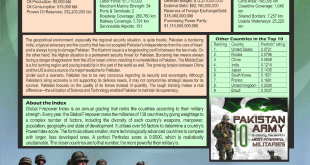Is it just a coincidence that when Prime Minister Nawaz Sharif was putting his foot on the American soil on October 20, the Pak-US relations also turned 66? Pak-US bilateral relations were established on October 20, 1947.
October 2013 brought another happenstance with it; Eid-ul-Azha, on October 16, marked the sacrifice of 7 million animals by Pakistanis, however, many would have recalled the very day when Pakistan’s first premier, Nawabzada Liaquat Ali Khan, was assassinated in Rawalpindi.
October is the very month when Gen Muhammad Ayub Khan imposed martial law. And, days before he embarked on visit to the US, Mian Nawaz Sharif must have the reminiscence of the 12th October, 1999 coup. Coincidently, interior minister Ch. Nisar Ali Khan announced to try Musharraf for ‘treason’ on the same date when Musharraf staged the coup.
The Bilawal Bhutto’s speech on October 16th also had raised many eyebrows.
Thus, the month of October definitely leaves its traces on Pak-US relations some way or the other. It is also pertinent to mention here that many Op-Eds on the massive, devastating earthquake of October 2005, that rocked AJK and KP, pointed to the possibilities that it may have been a quake created through the use of Harp Technology.
A retrospective look at Pak-US relations is essential especially with regard to foreign policy. Quaid-e-Azam gave the contours of Pakistan’s foreign policy immediately after the independence in the following words:
‘Our foreign policy is one of the friendliness and goodwill towards all the nations of the world. We do not cherish aggressive designs against any country or nation. We believe in the principle of honesty and fair-play in national and international dealings, and are prepared to make our contribution to the promotion of peace and prosperity among the nations of the world.’
Pakistan and India went to a war over Kashmir in 1948 in which nearly half of the Kashmir was liberated. Those were the times when the Cold War was brewing in and the blocs of US and the former USSR were being created. The communist USSR, despite being well aware of Pakistan’s geostrategic importance, preferred India for the establishment of relations. Main reason behind this was Pakistan’s creation on the basis of Islamic ideology.
Most historians narrate another reason behind Russian tilt, that is in 1927, India’s first premier, Pundit Jawaharlal Nehru, participated in the tenth anniversary of Soviet Communist Revolution as a leader of India; almost 20 years before partition of the Subcontinent, and he had friendly relations with the Russian leadership.
Hence, in 1950, when Liaquat Ali Khan received invitations both from USA and Russia, senior bureaucrats suggested that USA should be preferred so that the Indo-Russian nexus in the region may be countered. Unfortunately, it did not remain limited to the preference, and very soon, strains in the relations came to the fore.
Hence, at a time when Iran and Afghanistan were the regions of interest for Russia, Sino-Indian relations were also strong, Liaquat Ali Khan went to the United States, in 1950, on the ‘invitation’ of President Truman.
His delegate wanted to ensure military aid rather than the economic one. On the other hand, Mr Truman also expressed his desire to building US military bases in Pakistan. Liaquat Ali Khan not only turned down his request, he went on to say that Pakistan had got half of the Kashmir liberated without their help. Very soon after this interaction, Liaquat Ali Khan was assassinated and Khawaja Nazimuddin, the then Governor General, took over as the Prime Minister while Malik Ghulam Muhammad became the Governor General. He later dismissed Nazimuddin government invoking Article 6 of the Government of India Act 1935.
Is it interesting or ironic that people who were in Liaquat-led delegation to the US and who had meetings with Mr Truman, came to the power one after the other ‘Malik Ghulam Muhammad became Governor General; and was later replaced by Iskander Mirza who later became the first President of Pakistan; H.S.
Suhrawardy became the Prime Minister and lastly, the Commander-in-Chief, Field Marshal Muhammd Ayub Khan, became the President.
It must be kept in mind that in 1955, Pakistan gave in to the demand of the US for establishing a military base in Pakistan and that too on their own terms and conditions.
The US military training also entered Pakistan in 1953 along with the American wheat and in May 1954 both countries entered into a bilateral defence agreement under which hundreds of Army officers were sent to the US for military training. In 1955-56, in consultation with the then US Secretary of State, John Foster Dulles, Military Assistance Advisory Group (MAAG) was established at the GHQ, Rawalpindi.
H.S. Suhrawardy, who had allowed the establishment of a US military base near Peshawar, soon felt that the US is augmenting relations with the military and bureaucracy rather than the political leadership. He even complained it to the US President Eisenhower.
In October 1958, Ayub Khan imposed martial law and within no time, he went to the US where he successfully got support for his rule. He also assured the US leadership to pursue American interests in South Asia, Middle East and other regions.
It also wants special mention that no Pakistani leader, civil or military, could enter the said US base. In 1959, when Z.A. Bhutto intended to go there, his entry was prevented. Pakistan only knew that this base is being used to keep watch over the USSR, being oblivious to the realities.
The first setback for Pakistan was the halt in the provision of supplies and spares to Pakistan during the 1965 Indo-Pak War. Pakistan had to bear a loss of US$500 million and country’s fast-paced economic growth went into the doldrums. In 1969, when President Ayub bade adieu to the nation, Gen Yahya Khan imposed another martial law in the country.
Time has proved that the policy with regard to the Pak-US relations as well as for the military aid was not prudent at all. Major chunk of this aid went to the West Pakistan, which gave birth to an impression that the 1965 war is actually a war between India and the West Pakistan. During Yahya regime, 1970 General Elections were held and India occupied East Pakistan on 16 Dec 1971.
In July 1971, Henry Kissinger embarked on a clandestine visit to China but the Russians did not remain unaware of it. Only days before this visit, Sino-Russian border skirmishes had begun. Russia, considering China-Pakistan-USA alliance a threat to her, concluded a military pact with India which envisaged that an attack on one country would be considered an attack on the other. Hence, when India attacked East Pakistan in 1971, President Nixon ordered to send a naval ship to the Indian Ocean; however, it was delayed until India had ample time to occupy East Pakistan. Nevertheless, advancement of Indian military was halted on US pressure. The US didn’t resort to a prompt military action in the Bay of Bengal owing to the Indo-Russian war pact.
Bhutto had family relations with President Nixon. Despite he had met Nixon in 1972, after assuming power Bhutto successfully endeavoured to formulate an independent foreign policy. Given the geostrategic location of Pakistan, it was not, at all, in the American interest. Nuclear programme, OIC Summit and Pakistan’s key role in its decisions, socialist policy of nationalisation, establishment of economic and political relations with the Soviet Union, North Korea, Vietnam and the Warsaw Pact and NAM countries, were the policies which aroused US animosity against Bhutto. Things went fairly well until 1976 owing to his relations with Nixon, however, when Jimmy Carter became the US President, Bhutto came under fire.
Interestingly, Bhutto, in 1972, had gifted a pricey chess set to President Ford ‘probably a symbolic expression of a wish to outsmart the Americans with political manoeuvring. Finally, Bhutto was ousted in 1977 coup.
During 1972-77, American aid, friendship and cooperation had very little to do with Pakistan’s foreign policy. The period between 1979 and 1988 was another highly-important epoch in US-Pak relations, the US continued the economic and military aid to Pakistan despite the fact that it successfully completed the final process of fulfilling the cherished dream of being an atomic power. Nevertheless, this phase in relations did not end well for Pakistan, particularly after the withdrawal of Russian forces under the Geneva Accord. General Zia and other senior military officials including Gen Akhtar Abdur Rahman died on 17th August, 1988, in, apparently, a plane crash that happened at a time when the Cold War was fast heading towards its culmination.
Next came the democratic setup whereby both Nawaz Sharif and Benazir Bhutto came into power for two terms each. During this period, though the economy remained depressed and flagging, Pakistan became a proclaimed nuclear power on 28th May 1998.
The US opted for a ‘don’t care’ policy towards Pakistan during these years. Pakistan was tangled in worsened law and order situation and a faltering economy insomuch that General Pervez Musharraf ousted the Nawaz Sharif government.
In 2001, immediately after the 9/11 attacks, the US launched the War on Terror, and it once again needed Pakistan’s help. However, this time the American behaviour was quite intimidating and spooking and it gave Pakistan a clear warning: Be with us otherwise you are with the terrorists. Pakistan aligned with the US and took part in operations against Taliban and Al-Qaeda. But, American military and political leadership started openly criticising, and even doubting, Pakistan’s cooperation in this war knowing well that the acts of violence and terrorism marred Pakistan insomuch that they ranked Pakistan with the countries like Iraq and Afghanistan.
In 2006, the heinous acts of terrorism increased and the resultant devastation and ravages in KP, Balochistan and Karachi soared to new, alarming heights. The ruination due to suicide attacks, bomb blasts, sectarianism, nationalism and linguistic prejudice reached new extremes and still is rampant. Pakistan Peoples Party government completed its term in such circumstances.
Pakistan has, until now, borne a colossal loss of US$80 and more than 50,000 Pakistanis have lost their lives in terrorist acts. According to the 2010-11 data, Pakistan received US$20.70 billion in aid. After 2008, Allied forces, Afghanistan and some other countries resorted to term Pakistan as the promoter of terrorism while, on the other hand, the US incessantly urged Pakistan to “do moreâ€. The Raymond Davis incident and killing of Osama bin Laden in Abbottabad in May 2011 further deteriorated the already-worsened relations between the two countries.
Today, when America has exhausted and enervated in Afghanistan and is facing daunting challenges on the economic front, it has to decide whether relations with Pakistan are indispensable to it or not. It is the duty of Mian Nawaz Sharif and of Pakistani think tanks to make President Obama, American policymakers and their think tanks that keeping along Pakistan is inevitable for them. This gets more important because there is incessant lobbying to make Americans believe that the home to 180 million people and a country important geo-strategically, Pakistan, is a threat due to its precarious law and order conditions.
Pakistan had lost one president and two prime ministers during the Cold War years. Moreover, the War on Terror had devoured former Pakistani premier Ms Benazir Bhutto. Many important mujahideen leaders and six Afghan presidents had fallen prey to this monster; former US President John F. Kennedy became a victim of this too and the fight is still on in form of War on Terror.
This war is above and beyond the borders and any of the UN resolutions. So, unless ten major powers carve out a consensus multilateral agreement, no full stop could be put to terrorism. Nawaz Sharif has officially visited the USA after almost sixteen years. During his visit, in addition to his meetings with many bigwigs of the US administration, he had a long one-on-one meeting with President Obama. The statements and points of view in this visit look positive and bode well for the future. Before his arrival on the American soil, a tranche of Coalition Support Fund (CSF) was released to Pakistan. President Obama has also requested the Congress to revive the military aid of US$ 300 million to Pakistan. However, the very next day, it was ‘made clear’ that the drone attacks policy would continue, all evidence regarding Hafiz Saeed should be handed over to the US, don’t mention Dr Afia Siddiqi case, and Pakistan should improve the situation on the LoC.
Pakistan and the US are now on the crossroads. They can cross over so as to never look back again but most probably it would be prudent and better as well if both countries go on arm in arm.
 Jahangir's World Times First Comprehensive Magazine for students/teachers of competitive exams and general readers as well.
Jahangir's World Times First Comprehensive Magazine for students/teachers of competitive exams and general readers as well.


